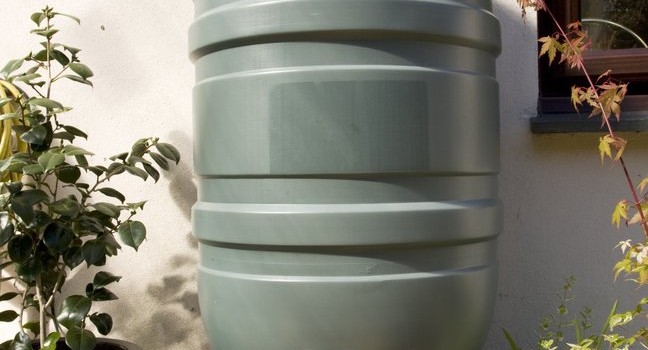
Introduction to rainwater harvesting
Rainwater harvesting (sometimes referred to as RWH) describes the process of collecting rain that falls onto a catchment area. In most cases, the catchment area is the roof of your house, where the rain falls and is then bought to a central point via guttering and down-pipes, before entering a storage tank. In more straight forward water harvesting systems, this storage tank can simply be a water butt, where the water can be tapped off and used in the garden. There are more complex water harvesting systems that are discussed later, which filter the water, even potentially getting to a suitable level for drinking. However on the whole, water harvesting is much simpler than recycling grey water or treating domestic sewage.
Uses for harvested rainwater
If your major catchment area is your roof, then we recommend putting in a very simple water butt at the bottom of a drain pipe so it catches rainwater that can be used in times of drought, to water your plants. When the rain falls on the roof though, it will likely pick up pollutants, potentially from the air (e.g. exhaust fumes), but also things like bird faeces on your roof, therefore water from this source is not drinkable unless it undergoes further treatment.
Using a simple sand filter system, you can remove the vast majority of pollutants and larger contaminants, so this water will then be okay to use to flush toilets. In order to do this you will need to use a specialised sealed water container and a submersible pump to get the water to where you need it. This will increase the cost of your water harvesting system.
If suitable treatment is in place you can make the rainwater suitable for drinking too. Filters can be used, e.g. a particulate filter that remove particles that are larger than 5 microns in diameter, which can be used in conjunction with ultraviolet light sterilisers, which also kill any dangerous microorganisms in the water to make the water drinkable. Due to the filtration technology needed to support this system, this will be the most maintenance heavy and financially expensive system, but it will certainly reduce your reliance on the water companies once installed and over time will naturally lower your water bills (after the initial capital expenditure).
It is also important to note that there are other catchment areas to fulfil your rainwater harvesting needs, such as roads or parks. These have the advantage of a massive catchment area, so work better when there is little rainfall, but at the same time the water runoff from these catchment areas is more contaminated with things like oil from cars and other waste, so it takes more filtration to get the water into a suitable fashion for use in your home.
Types of rainwater harvesting system
A simple water butt can be bought from most good DIY stores (e.g. Homebase or B&Q), and they start from about £30-£40. They obviously come in different shapes and sizes to accommodate your needs, but obviously if you have very little rainfall, then getting an enormous water butt may be unwise, as it will be more expensive and take up more room when it is not actually going to be used. In addition, if you let it fill over the winter, you can use it in the spring to provide water for your garden; but note that if the water has been stagnant for quite some time, it is highly probable that algae and other microbes may have made into their home!
If you are looking for a slightly grander water harvesting system, with water to be used inside the house (not just for gardening and washing the car), but for completing everyday tasks such as flushing the toilet, it is worth sizing the storage tank by looking at several factors.
Obviously the local average rainfall is the major factor, the more rain that falls the more rainwater you can collect. The size of the roof will obviously play a large part in this, as this essentially defines your catchment area. It doesn’t matter if you live in the vicinity of Victoria Falls, if you only have a small roof, it is going to limit the amount of water you can collect.
The final thing to think about is the actual volume of water you require, ideally you don’t want the water to sit in the tank for extended periods of time as algae and other microbes will start growing. Ideally you almost want to use the water as you harvest it, minimising turnaround. A tank size calculator can be found here, though you will need to know the approximate dimension of your house to use this tool.
Water harvesting building regulations
These systems are best installed as a new build project or when undergoing major regenerations to a house. In the UK all new were rated under the Code for Sustainable Homes (CLG 2008), but this was replaced by a voluntary quality management scheme in 2015, which is the Home Quality Mark (HQM). Although not mandatory, there are standards in the HQM, which talk about the best practices to reduce potable water consumption – including harvesting rainwater as one of the ways to meet this. The theory being that to decrease the consumption of potable water, alternative sources of water are used for lower grade uses such as toilet flushing and irrigation. Most of these systems don’t need planning permission, and as of 2007 councils were directed to give sympathetic handling of planning permission to applications that include rainwater harvesting.
Benefits
- Collecting free rainwater to supply non potable services (such as toilet flushing) reduces mains water consumption by up to 50%.
- Water butts can help guard against drought, acting as a small reservoir.
- The water supply is currently under stress – so harvesting rainwater can help decrease dependence on mains water.
Limitations
- Supplies can be contaminated by bird and animal droppings on the catchment surfaces.
Cost
- The cost of a rain harvesting kit depends on how much water you want to collect, and what you want to do with the water. A simple water butt connected to the drain will cost from £30 – £300, but if you need to treat and purify the water the system could end up costing £2,000-£3,000.












No Comments yet! Be the first one.